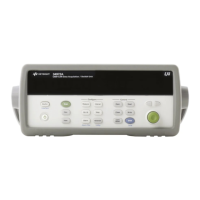4 Features and Functions
172 Keysight 34970A/34972A User’s Guide
Error conditions
When the front-panel ERROR annunciator turns on, one or more command
syntax or hardware errors have been detected. A record of up to 10 errors
(34970A) or 20 errors (34972A) is stored in the instrument’s error queue. See
Chapter 5 for a complete listing of the errors.
– Errors are retrieved in first-in-first-out (FIFO) order. The first error returned is
the first error that was stored. Errors are cleared as you read them. When you
have read all errors from the queue, the ERROR annunciator turns off and the
errors are cleared. The instrument beeps once each time an error is generated.
– If more than 10 errors (34970A) or 20 errors (34972A) have occurred, the last
error stored in the queue (the most recent error) is replaced with “Error queue
overflow”. No additional errors are stored until you remove errors from the
queue. If no errors have occurred when you read the error queue, the
instrument responds with “No error”.
– The error queue is cleared by the *CLS (clear status) command or when
power is cycled. The errors are also cleared when you read the queue. The
error queue is not cleared by a Factory Reset (*RST command) or an
Instrument Preset (SYSTem:PRESet command).
– Front-Panel Operation:
ERRORS
If the ERROR annunciator is on, press
to view the error. Use the knob to
scroll through the error numbers. Press to view the text of the error
message. Press again to increase the scrolling speed (the final key press
cancels the scroll). All errors are cleared when you exit the menu.
– Remote Interface Operation:
Errors have the following format (the error string may contain up to 80
characters):
-113,"Undefined header"
SYSTem:ERRor? Read and clear one error from the queue

